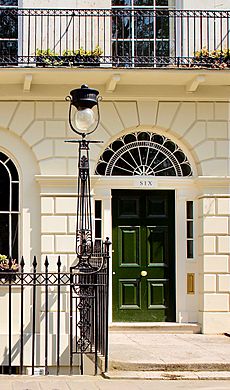The Georgian Group facts for kids
| Formation | 1937 |
|---|---|
| Headquarters | 6 Fitzroy Square, London, England |
|
Membership
|
Open |
|
Patron
|
Charles III |
|
President
|
Eleanor Campbell, Duchess of Argyll |
|
Chairman
|
Paul Zisman |
|
Director
|
Dr Anya Lucas |
The Georgian Group is a special charity in Britain. It helps protect and celebrate old buildings from the Georgian era. This was a time between 1700 and 1837 when a certain style of architecture was popular. The Group works to save these beautiful buildings in England and Wales. They are like guardians for historic places. If someone wants to change or knock down a Georgian building that is "listed" (meaning it's officially protected), the Georgian Group must be told. They make sure these important buildings are treated with care.
Contents
History of the Georgian Group
The Georgian Group started in 1937. It was founded by Lord Derwent, Robert Byron, and Douglas Goldring. Douglas Goldring also became the first secretary. The Group was first part of another organization. This was the Society for the Protection of Ancient Buildings.
Many famous people were involved early on. These included Nikolaus Pevsner, Sir John Betjeman, and Sir John Summerson. Since 1971, the Georgian Group has been known as a national "amenity society." This means it's an important group that helps protect our heritage.
What the Georgian Group Does
The Georgian Group plays a big role in protecting old buildings. When someone plans to change or demolish a listed building from 1700 to 1837, the Group gets involved. They give advice on these plans. This helps make sure historic buildings are kept safe.
The Victorian Society does similar work for buildings from 1837 to 1914. The Georgian Group receives thousands of requests for advice each year. In Scotland, a group called the Architectural Heritage Society of Scotland does similar work.
Protecting Churches and Chapels
The Group also advises churches on changes to their historic buildings. This includes churches from the Church of England and Church in Wales. They also help Methodist, Roman Catholic, Baptist, and United Reformed churches. They make sure that old parts of these buildings are not removed or changed without careful thought.
Group Headquarters and Resources
The Georgian Group's main office is at 6 Fitzroy Square in London. This is a large, historic house designed by Robert Adam. The Group has carefully restored it. Inside, they have a huge library. They also have a collection of old architectural drawings and pictures. These are called the Pardoe Collection. People can visit by making an appointment.
Helping People Protect Buildings
Since the 1980s, the Georgian Group has had special experts. These experts are called caseworkers. They help with planning issues in different regions. Anyone can ask the Group for help to save a Georgian building. The Group has four main regions: London and the South East, Central and Northern England, South West England and the Cotswolds, and Wales. These experts work with a Senior Caseworker and a team of advisers.
Architectural Awards
The Georgian Group gives out special awards every year. These are called the Architectural Awards. They started in 2003. The awards celebrate amazing projects that restore old buildings and landscapes. These projects are in the UK, Isle of Man, or Channel Islands. They focus on buildings from 1660 to 1840.
Award Categories
The awards have different categories. These include:
- Restoring a Georgian Country House
- Restoring a Georgian Interior (inside a building)
- Restoring a Georgian Building in a City
- Finding New Uses for a Georgian Building
- Restoring a Georgian Garden or Landscape
- Building a New Building in the Georgian Style
- Building a New Building that fits with Georgian surroundings
Past Award Winners
Many famous places have won these awards. Some past winners include the Great Pagoda, Kew Gardens. Also, the Saloon at Brighton Pavilion and the Painted Hall at Greenwich have won. Other winners include Pitzhanger Manor in Ealing and Hillsborough Castle in Northern Ireland. Many private homes have also received awards.
Grants for Restoration
The Georgian Group also has a small fund. It's called the F. E. Cleary Heritage Fund, or The Cleary Fund. This fund gives grants to help repair and restore Georgian buildings. It also helps with monuments and old fixtures. Grants are usually given out once a year in October.
Other Groups Like This
- Irish Georgian Society
- The Twentieth Century Society


